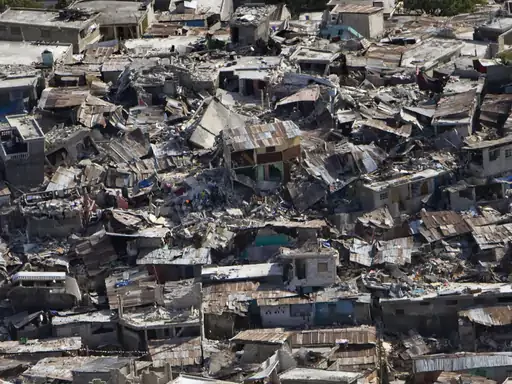Kathmandu – The earthquake that struck Myanmar on March 28 has killed more than 1,500 people so far. The death toll is estimated to reach 10,000. This devastating 7.7-magnitude earthquake is not included in the list of the top 10 earthquakes that have hit the world in the 21st century.
The 10 most powerful earthquakes of the 21st century have killed about 600,000 people. Thousands of people went missing in those earthquakes and millions were left homeless. The earthquakes caused great destruction in many countries in Asia, Europe, Africa and America. Millions of homes, historic buildings and infrastructure were destroyed due to those earthquakes.
These are the 10 most powerful earthquakes of the 21st century
1. 2004: Indian Ocean earthquake and tsunami
Intensity: 9.2-9.3
Deaths: 230,000
On December 26, 2004, an earthquake measuring 9.2-9.3 on the Richter scale struck near the Indonesian island of Sumatra. It was the most powerful earthquake of the 21st century, causing a devastating tsunami. It affected 14 countries, including India, Sri Lanka, Thailand, Maldives, and Somalia, and killed more than 230,000 people.
The tsunami wave that followed the earthquake was 30 meters high, causing widespread destruction in coastal areas. Millions of people were left homeless. The tsunami that followed the earthquake led to the establishment of a tsunami warning system in the Indian Ocean to reduce the damage from such events in the future.
2. 2010: Haiti earthquake
Intensity: 7.0
Deaths: 200,000–300,000
On January 12, 2010, a 7.0 magnitude earthquake struck near the capital of Haiti, Port-au-Prince. The earthquake killed 200,000 to 300,000 people and left millions homeless. The earthquake destroyed government buildings, hospitals, schools, and infrastructure.
After the earthquake, many countries sent aid and relief to Haiti in the relief efforts. However, weak governance and a lack of resources hampered relief efforts. The earthquake had a long-term impact on Haiti’s economy and society. The United Nations and international organizations played a significant role in the reconstruction effort.
3. 2008: Sichuan (China) earthquake
Intensity: 7.9
Deaths: 87,587
On May 12, 2008, a 7.9-magnitude earthquake struck Sichuan Province, China, causing widespread destruction. The earthquake killed more than 87,000 people and injured nearly 375,000.
The epicenter of the earthquake was in Wenchuan County, but the tremors were felt as far away as Beijing and Shanghai. Thousands of schools, hospitals, and buildings were destroyed, and millions were left homeless.
The Chinese government launched relief and reconstruction efforts, spending 4.8 trillion yuan (about $146 billion). The earthquake was one of the deadliest natural disasters in China.
4. 2005: Kashmir earthquake
Intensity: 7.6
Deaths: 87,351
On 8 October 2005, a devastating 7.6-magnitude earthquake struck Pakistan-administered Kashmir and the Indian state of Jammu and Kashmir. Its epicenter was near Muzaffarabad, Pakistan. The earthquake killed more than 80,000 people and injured more than 100,000. About 4 million people were left homeless.
The earthquake destroyed thousands of buildings, schools, and hospitals in Pakistan, India, and Afghanistan. Relief efforts were hampered by bad weather and difficult mountainous terrain. It was one of the deadliest earthquakes in South Asia, causing widespread destruction in the region.
5. 2023: Turkey-Syria earthquake
Intensity: 7.8
Deaths: 62,131
On 6 February 2023, a devastating 7.8-magnitude earthquake struck Turkey and Syria. Its epicenter was in the Gaziantep province of Turkey. A few hours later, another earthquake measuring 7.5 struck. This earthquake killed more than 62,000 people and injured thousands more. Millions of people were left homeless. Thousands of buildings collapsed in Turkey and Syria.
Rescue teams were sent from around the world, but the war in Syria hampered rescue efforts. It is considered the most destructive earthquake in Turkey’s history.
6. 2003: Bam (Iran) earthquake
Intensity: 6.6
Deaths: 26,000
On December 26, 2003, a devastating 6.6-magnitude earthquake struck the Iranian city of Bam. The earthquake killed more than 26,000 people and injured more than 30,000. The earthquake destroyed about 755 buildings. The world’s largest earthen structure, the historic Arg-e Bam fortress, was also severely damaged.
7. 2001: Gujarat (India) earthquake
Intensity: 7.7
Deaths: 20,085
On 26 January 2001, a 7.7 magnitude earthquake struck Gujarat. Its epicenter was near Bhuj in Kutch district. More than 20,000 people were killed and over 167,000 injured. About 400,000 houses were destroyed by the earthquake. Bhuj, Ahmedabad, Gandhinagar and other cities were severely damaged. Roads, electricity and communication systems were badly affected.
8. 2011: Tohoku (Japan) earthquake and tsunami
Intensity: 9.0
Deaths: 19,759
On 11 March 2011, a 9.0 magnitude earthquake struck the Tohoku region of Japan. It was the deadliest earthquake in Japanese history.
Send feedback
Side panels
History
Saved
The earthquake was the most powerful in recorded history. The earthquake was followed by a 40-meter-high tsunami that devastated coastal cities. The disaster killed about 20,000 people and left millions homeless. The Fukushima nuclear plant caused a serious environmental crisis.
9. 2015: Nepal earthquake
Intensity: 7.8
Deaths: 8,964
A 7.8-magnitude earthquake struck Nepal on April 25, 2015. The epicenter of the earthquake was Barpak in Gorkha district. The earthquake killed more than 8,800 people. The earthquake injured more than 22,000 and left millions homeless. Historic sites in Kathmandu, Bhaktapur, and Lalitpur were destroyed, including the Dharahara tower and several ancient temples. The earthquake was followed by several powerful aftershocks, causing further damage. The earthquake also killed 51 people in India and injured 237. Countries including India and China assisted in relief and rescue operations.
10. 2006: Yogyakarta (Indonesia) earthquake
Intensity: 6.4
Deaths: 5,782
On May 27, 2006, a devastating 6.3-magnitude earthquake struck Yogyakarta, Indonesia. Its epicenter was on the island of Java. The earthquake killed more than 5,700 people and injured more than 38,000. About 600,000 people were left homeless by the earthquake. Thousands of homes, schools, hospitals, and historical sites were destroyed.
The earthquake increased the possibility of the Merapi volcano becoming active. It was one of the deadliest earthquakes in Indonesia, causing widespread destruction in Yogyakarta and the surrounding areas.


Comments are closed.